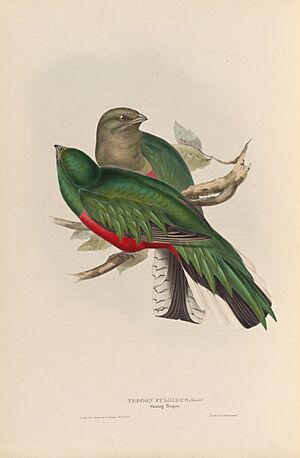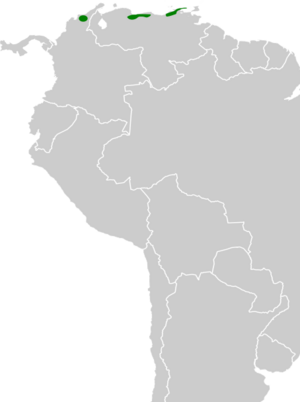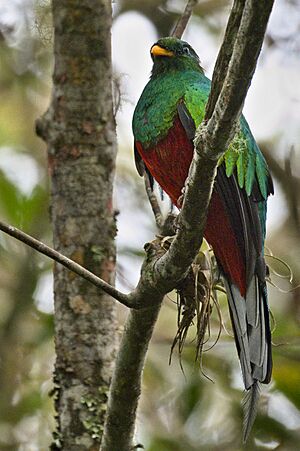White-tipped quetzal facts for kids
Quick facts for kids White-tipped quetzal |
|
|---|---|
 |
|
| Conservation status | |
| Scientific classification | |
| Genus: |
Pharomachrus
|
| Species: |
fulgidus
|
 |
|
The white-tipped quetzal (Pharomachrus fulgidus) is a beautiful bird that lives in the forests of Venezuela, Colombia, and Guyana. These birds are known for their bright, shimmering feathers. They are found in forests, woodlands, and humid mountain areas. The white-tipped quetzal is a type of quetzal, which are famous for their amazing colors. Scientists have not studied this bird as much as others. However, it is currently not considered an endangered species.
Contents
What Does It Look Like?
Male and Female Birds
Adult male white-tipped quetzals are very colorful. They have a shiny, golden-green head and neck. Their chest, back, and upper tail are bright green. The male's beak is yellow, and its feet are dark brown. Their belly and the feathers under their tail are a striking red. Their wings and upper tail are black. The feathers under their tail are white, which gives them their name. These white tips can be quite long. Males also have short feathers on their forehead that look like a small crest.
Female quetzals are not as shiny as the males. They do not have the crest on their head. Their throat, belly, and chest are brownish-grey, with a green band. Their beak and feet are yellowish-brown or grey. Females also have white tips on their outer tail feathers, but they are narrower.
Young Quetzals
Young quetzals, both male and female, have mixed buff and white feathers when they are chicks. Their feathers are also narrower and more pointed than adult feathers. Young females have a brown chest.
Special Feet
Quetzals and other trogons have unique feet. They are the only birds with a special toe arrangement called heterodactyl. This means two toes point forward and two toes point backward.
Bird Calls
Scientists describe the white-tipped quetzal's call as a loud kirra. Sometimes it sounds like kirra, kip. When the bird is excited, it might make sounds like kier, kip-kip-kip-a.
Where Do They Live?
The white-tipped quetzal lives only in northern South America. You can find them in Colombia, Venezuela, and Guyana. In Colombia and Venezuela, they live in high tropical and subtropical areas.
These birds live in many different places. They can be found in cloud forests, regular forests, and even coffee farms. They prefer places that are cool and humid. This is likely because these areas have plenty of berries to eat. They also offer small holes in trees where they can build their nests.
Life Cycle and Habits
Reproduction and Nests
White-tipped quetzals usually breed at the end of the dry season. This is between January and April. Their breeding time seems to match when fruits are most available in the forest. Having lots of food helps them during this important time. It gives them energy for courtship, nesting, and raising their chicks.
Quetzal nests are often in old holes made by woodpeckers. They also use holes in dead tree trunks, usually 4 to 10 meters (13 to 33 feet) above the ground. Sometimes, they even nest in termite nests. They lay 2 to 4 eggs, which can be white or light-colored.
Young quetzals are born without feathers. They grow their feathers quickly. They leave the nest after about three weeks. They get their adult feathers after their second major feather change.
What Do They Eat?
The white-tipped quetzal mainly eats fruits and berries. They often fly from a branch to grab food and then return to their perch to eat it. One quetzal was even seen eating a large lizard. Their wide beaks and weak legs show that they mostly eat food found in trees.
Behavior and Movement
Scientists have not studied the white-tipped quetzal's specific behaviors much. However, they likely act like other birds in the trogon family. White-tipped quetzals are fast flyers. But they do not like to fly long distances. Trogons usually do not migrate, meaning they stay in one area. The white-tipped quetzal is thought to be a bird that stays in one place.
Trogons are often quiet and still when they are not flying to find food. They usually find food by flying from a perch to a branch or leaves. They hover, grab the food, and then fly back to their perch to eat it.
Even though they are very colorful, white-tipped quetzals are not very active. This quiet behavior might be a way to protect themselves from predators. They keep their bright feathers hidden by moving from branch to branch. They also use their flexible necks to look around, turning their heads up to 180 degrees. These actions help them blend in with their wooded homes.
Threats to Quetzals
We do not know much about what animals hunt the white-tipped quetzal. However, other trogons have been hunted by mammals and hawks. For example, a Resplendent quetzal was once caught by a margay while it was caring for its chicks.
Quetzals can also get parasites, like those found on songbirds or pigeons. One type of parasite, Ornithoctona nitens, seems to affect only the trogon family.
A big problem for white-tipped quetzals is finding places to nest. They need old tree cavities. If there are not enough nesting spots, it can affect how many chicks survive. Losing their forest homes is also a growing threat. Even careful logging, like removing dead trees, can harm these birds. This is because they rely on these trees for their nests.
Population and Protection
Where Are They Found?
The white-tipped quetzal lives only in the Americas. In Venezuela, they are found in mountains at heights of 900 to 1900 meters (about 3,000 to 6,200 feet). In Colombia, they live in the Santa Marta mountains at 1500 to 2500 meters (about 4,900 to 8,200 feet). One quetzal was seen at a lower height in Venezuela, suggesting they might live in a wider range of places.
They also live in Guyana, but it is harder to find them there. This is probably because they live in the densest parts of the tropical forests. Even though they have a smaller range than other quetzals, they are quite common in the areas where they live. We do not have exact numbers for their population because they have not been studied much.
Conservation Status
The white-tipped quetzal is listed as a species of Least Concern by the IUCN Red List. This means their population is stable. It is not decreasing or changing a lot. Their habitat is also stable, and their population is not breaking into smaller groups. Because of this, there are no special plans to protect the white-tipped quetzal or its homes right now. However, scientists say that more research is needed to learn more about this bird.



